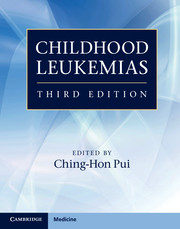Book contents
- Frontmatter
- Contents
- List of contributors
- Preface
- Section 1 History and general issues
- Section 2 Cell biology and pathobiology
- Section 3 Evaluation and treatment
- 12 Pharmacokinetic, pharmacodynamic, and pharmacogenetic considerations
- 13 Acute lymphoblastic leukemia
- 14 Relapsed acute lymphoblastic leukemia
- 15 B-cell acute lymphoblastic leukemia and Burkitt lymphoma
- 16 Acute myeloid leukemia
- 17 Relapsed acute myeloid leukemia
- 18 Myelodysplastic syndrome
- 19 Chronic myeloproliferative disorders
- 20 Leukemias in patients with Down syndrome
- 21 Treatment of adolescents and young adults with acute lymphoblastic leukemia
- 22 Hematopoietic stem cell and natural killer cell transplantation
- 23 Treatment of acute leukemia in countries with limited resources
- 24 Antibody-targeted therapy
- 25 Adoptive cellular immunotherapy
- 26 Gene transfer: methods and applications
- 27 Development therapeutics
- 28 Minimal residual disease
- Section 4 Complications and supportive care
- Index
- Plate Section
- References
28 - Minimal residual disease
from Section 3 - Evaluation and treatment
Published online by Cambridge University Press: 05 April 2013
- Frontmatter
- Contents
- List of contributors
- Preface
- Section 1 History and general issues
- Section 2 Cell biology and pathobiology
- Section 3 Evaluation and treatment
- 12 Pharmacokinetic, pharmacodynamic, and pharmacogenetic considerations
- 13 Acute lymphoblastic leukemia
- 14 Relapsed acute lymphoblastic leukemia
- 15 B-cell acute lymphoblastic leukemia and Burkitt lymphoma
- 16 Acute myeloid leukemia
- 17 Relapsed acute myeloid leukemia
- 18 Myelodysplastic syndrome
- 19 Chronic myeloproliferative disorders
- 20 Leukemias in patients with Down syndrome
- 21 Treatment of adolescents and young adults with acute lymphoblastic leukemia
- 22 Hematopoietic stem cell and natural killer cell transplantation
- 23 Treatment of acute leukemia in countries with limited resources
- 24 Antibody-targeted therapy
- 25 Adoptive cellular immunotherapy
- 26 Gene transfer: methods and applications
- 27 Development therapeutics
- 28 Minimal residual disease
- Section 4 Complications and supportive care
- Index
- Plate Section
- References
Summary
Introduction
A multitude of clinical and biologic factors have been associated with response to treatment in childhood acute leukemia but their predictive power is far from absolute, and their usefulness for guiding clinical decisions in individual patients is inherently limited. Rather than predicting treatment response, in vivo measurements of leukemia cytoreduction provide direct information on the effectiveness of treatment in each patient. Such estimates, when performed by conventional morphologic techniques, have a relatively low sensitivity and accuracy: in most cases, leukemic cells can be detected in bone marrow with certainty only when they constitute 5% or more of the total cell population. These limitations are overcome by methods for detecting minimal (i.e., submicroscopic) residual disease (MRD), which can be 100 times more sensitive than morphology and allow a more objective assessment of treatment response. The definition of “remission” in patients with acute leukemia by these methods has become the standard at many cancer centers.
Initial reservations about the clinical utility of MRD testing arose from concerns regarding the heterogeneous distribution of leukemia during clinical remission. Another concern was that MRD signals may not correspond to viable leukemic cells with the capacity for renewal. Indeed, even contemporary MRD assays cannot determine whether the signals detected originate from stem cells or from more differentiated cells incapable of driving durable cell growth. In view of the strong correlation between MRD levels and relapse, it is now clear that the presence of MRD in most cases directly or indirectly demonstrates the persistence of leukemic cells that are resistant to chemotherapy and are capable of driving the recurrence of leukemia.
- Type
- Chapter
- Information
- Childhood Leukemias , pp. 632 - 659Publisher: Cambridge University PressPrint publication year: 2012



